#mastic gum
Text

Mastic Gum - Klaire Labs
Mastic Gum is a sap like substance that comes from the mastic tree. It is chewed, like chewing gum, to alleviate digestive related conditions such as indigestion, heartburn and stomach pain. Mastic gum contains anti-bacterial, anti-fungal, anti-oxidant, and anti-inflammatory properties which enable it to provide relief from uncomfortable symptoms. Chewing mastic gum daily may help protect the stomach and gut from gastrointestinal problems.
Tablets are cinnamon flavoured and contain DGL (deglycyrrhizinated licorice root and rhizome extract). DGL is a soothing anti inflammatory herb, used for heartburn and stomach inflammation. It relieves symptoms and repairs the lining of the digestive tract.
SUGGESTED DOSAGE
Chew 1-2 tablets as needed or as directed by a healthcare professional Know more: https://purenaturals.co.uk/product/mastic-gum-dgl/
#best dietary supplements uk#digestive health supplement#health supplements#pure supplements#Mastic Gum#klaire labs
4 notes
·
View notes
Text
My coworker gave me Mastic Gum today (not to be confused with gum mastic, the resin used as incense). It's sweet, and flavoured with anise slightly, but holy heck it's so good!
It doesn't last as long as you'd hope, but honestly, the flavour is so unique and it feels a little magical, because it tastes like one of my favourite incenses smells, and I like that
1 note
·
View note
Text
Tag game! Name an uncommon thing you’ve given up or refuse to do, and (if you’re comfortable), why you gave it up.
I’ll start: I stopped chewing gum at age sixteen, because of the microplastics in gum base… however! I will chew chicle or other gum bases made from tree resin if I can get my hands on it for a reasonable price. Simply Gum is kinda… meh. It loses its flavor super fast. But it provides my mouth with an activity that doesn’t involve sucking the blood out of my lower lip, so that’s a plus.
Tagging: @astudyinpanda @straight-to-the-pain @redd956 @redwingedwhump @blackrosesandwhump @randomtwospirit @kaleidoscopr @fandomjumper247
or anyone
#tag game#whump community#I wanna try straight chicle or mastic gum because the texture looks cool but it’s so expensive
19 notes
·
View notes
Text
many experiences today
#we went over to türksan to get a panoramic xray of my teeth at the dentist (no elaboration)#then we went to my favorite good place again! third day in a row. they know us very well by now#i broke the bones of one of the chicken wings i ate while biting into it from the sheer amount of force i was putting on it.#i then got called ladylike once again by im assuming the owner. the people of turkey Love me#(<-has been called ladylike by three different nearly-strangers recently)#we then went to the ice cream place just across ^^ i got oreo ice cream and gum flavored ice cream#...gum..mastic gum? is it called mastic gum. thats what google says#oh whatever. its those unflavored ones#then we went to A101 (a grocery shop) but i waited outside because there were cats there#one was really sweet but there was a little kid (about 7 years old) that screamed at it and chased it. have not had homicidal thoughts in -#- a while but i did today#then we went home#was pretty nice! im very proud of having gotten called ladylike again only because that means its Working (me being nice)#🌙rambling#OH how dare i forget. on the minibus ride there we saw a god damned horse. and people were riding it with a carrier#i was very shocked. second time i've seen horses in this place
2 notes
·
View notes
Photo

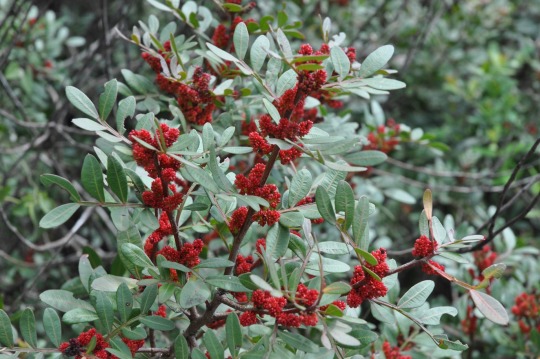

Mastic
Burned in rituals when summoning spirits.
Aids psychic powers and increases potency when used in an incense.
Dissolve and use in a love potion.
#love potion#lust#love#mastic#potency#spirit#psychic powers#gum mastic#masticke#pistachia galls#masculine#sun#air#manifestation#magic use#magical use#witchcraft#wiccan
3 notes
·
View notes
Text
Good Bacteria: Your Guide to a Healthy Microbiome
Discover the fascinating world of good bacteria and their vital role in maintaining our well-being. This informative article delves into the significance of good bacteria for our gut, skin, mouth, and overall health. Learn how to naturally increase the levels of these beneficial microorganisms and how they help fight against harmful pathogens. Uncover the impact of antibiotics and other factors on good bacteria, and explore ways to replenish them after treatment. From probiotics to fermented foods, find out what nourishes these friendly organisms and the essential functions they perform in our bodies. Embrace the power of good bacteria and optimize your health today!
#good bacteria#how to increase good bacteria in gut naturally#does oil of oregano kill good bacteria#good bacteria stomach#foods good bacteria#food with good bacteria#how to replenish good bacteria after antibiotics#berberine kills good bacteria#good bacteria for mouth#good bacteria gut#do antibiotics kill good bacteria#food for good bacteria in gut#mastic gum kills good bacteria#what kills good bacteria in gut#what are the good bacteria#foods for good bacteria in gut#good bacteria for the body#good bacteria examples#does boric acid kill good bacteria#does mouthwash kill good bacteria#does monolaurin kill good bacteria#good bacteria in vag#good bacteria yogurt#restoring good bacteria in mouth#mouth good bacteria#what mouthwash does not kill good bacteria#how to increase good bacteria in gut#how to increase good bacteria in mouth naturally#good bacteria vs bad bacteria#good bacteria killed by antibiotics
0 notes
Text
Dush Products
Dush Products – Mastics, Sealer, Epoxy, Polish, Densifiers, Cleaner, and Stain Remover have an origin from Italy’s best brands which are well-known in Europe. Now, these products are also available for the domestic Indian Market.
👉Get everything you need in the best-selling products with a limited-time offer! Visit our Website or Direct Call🌐 https://dushproducts.com/📞 𝟏𝟖𝟎𝟎𝟖𝟗𝟏𝟎𝟏𝟑𝟑

View On WordPress
#Adhesive#Cleaner#Densifiers#Dush#Dush Products#Epoxy#Granite#Gum#Marble#Mastics#Polish#Products#Sealer#Stain Remover#Tiles#Wood
0 notes
Text

[ID: Two plates of cookies, one oval and topped with powdered sugar, and the others shaped in rings; one cookie is broken in half to show a date filling; two glasses of coffee on a silver tray are in the background. End ID]
معمول فلسطيني / Ma’moul falastini (Palestinian semolina cookies)
Ma’moul (also transliterated “ma’amoul,” “maamoul” and “mamoul”) are sweet pastries made with semolina flour and stuffed with a date, walnut, or pistachio filling. The cookies are made tender and crumbly with the addition of fat in the form of olive oil, butter, or clarified butter (سمن, “samn”); delicate aromatics are added by some combination of fennel, aniseed, mahlab (محلب: ground cherry pits), mastic gum (مستكه, “mistīka”), and cinnamon.
“مَعْمُول” means “made,” “done,” “worked by hand,” or “excellently made” (it is the passive participle of the verb “عَمِلَ” “‘amila,” "to do, make, perform"). Presumably this is because each cookie is individually filled, sealed, and shaped by hand. Though patterned molds known as طوابع (“ṭawābi’,” “stamps”; singular طابع, “ṭābi’”) are sometimes used, the decorations on the surface of the cookies may also be applied by hand with the aid of a pair of small, specialized tongs (ملقط, “milqaṭ”).
Because of their laborious nature, ma’moul are usually made for feast days: they are served and shared for Eid, Easter, and Purim, a welcome reward after the Ramadan or Lenten fasts. For this reason, ma’moul are sometimes called “كَعْك العيد” (“ka’k al-’īd,” “holiday cakes”). Plates of the cookies, whether homemade or store-bought, are passed out and traded between neighbors in a practice that is part community-maintenance, part continuity of tradition, and part friendly competition. This indispensable symbol of celebration will be prepared by the women of a family even if a holiday falls around the time of a death, disaster, or war: Palestinian food writer Laila El-Haddad explains that "For years, we endured our situation by immersing ourselves in cooking, in our routines and the things we could control."
Other names for these cakes exist as well. Date ma’moul–the most common variety in Palestine–may be called كَعْك بعَجْوَة (“ka'k b'ajwa”), “cakes with date paste.” And one particular Palestinian variety of ma’moul, studded with sesame and nigella seeds and formed into a ring, are known as كَعْك أَسَاوِر (“ka'k 'asāwir”), “bracelet cakes.” The thinner dough leads to a cookie that is crisp and brown on the outside, but gives way to a soft, chewy, sweet filling.

[ID: An extreme close-up on one ka'k al-aswar, broken open to show the date filling; ma'moul and a silver teapot are very out-of-focus in the background. End ID]
History
Various sources claim that ma’moul originated in Egypt, with their ancestor, كحك (kaḥk), appearing in illustrations on Pharaonic-era tombs and temples. The more specific of these claims usually refer to “temples in ancient Thebes and Memphis,” or more particularly to the vizier Rekhmire’s tomb in Thebes, as evidencing the creation of a pastry that is related to modern kahk. One writer attests that this tomb depicts “the servants mix[ing] pure honey with butter on the fire,” then “adding the flour by mixing until obtaining a dough easy to transform into forms” before the shaped cookies were “stuffed with raisins or dried dates and honey.” Another does not mention Rekhmire, but asserts that “18th-dynasty tombs” show “how honey is mixed with butter on fire, after which flour is added, turning the substance into an easily-molded dough. These pieces are then put on slate sheets and put in the oven; others are fried in oil and butter.”
Most of these details seem to be unfounded. Hilary Wilson, summarizing the state of current research on Rekhmire’s tomb, writes that the depicted pastries were delivered as an offering to the Treasury of the Temple of Amun; that they certainly contained ground tiger nuts; that they presumably contained wheat or durum flour, since ground tiger nuts alone would not produce the moldable dough illustrated; that the liquid added to this mixture to form the dough cannot be determined, since the inscription is damaged; that the cakes produced “are clearly triangular and, when cooked are flat enough to be stacked” (any appearance that they are pyramidal or conical being a quirk of ancient Egyptian drawing); that they were shallow-fried, not cooked in an oven; and that honey and dates are depicted at the far left of the scene, but their relationship to the pastries is unclear. There is no evidence of the honey being included in the dough, or the cookies being stuffed with dates; instead, Wilson speculates that “It appears that the cooks are preparing a syrup or puree of dates and honey. It is tempting to think that the cakes or pastries were served [...] with a generous portion of syrup poured over them.” Whether there is any direct lineage between these flat, fried pastries and the stuffed, molded, and baked kahk must also be a matter of speculation. [1]
Another origin claim points to ancient Mesopotamia. James David Audlin speculates that ma’moul are "possibly" the cousins of hamantaschen, both being descended from the molded "kamānu cakes that bore the image of [YHWH’s] goddess wife Inanna [also known as Ishtar or Astarte]" that were made in modern-day Syria. Other claims for Mesopotamia cite qullupu as the inspiration: these cakes are described in the contemporary record as wheat pastries filled with dates or raisins and baked. (Food historian Nawal Nasrallah writes that these cookies, which were offered to Ishtar for the new year festival in spring, may also be an origin point for modern Iraqi كليچة, "kleicha.")
The word "määmoul" had entered the English language as a type of Syrian farina cake by 1896.
In Palestine
From its earliest instantiations, Zionist settlement in Palestine was focused on building farming infrastructure from which Palestinians could be excluded: settlers, incentivized by foreign capital, aimed at creating a separate economy based around farms, agricultural schools, communal settlements, and research institutions that did not employ Arabs (though Arab labor and goods were never entirely cut out in practice).
Zionist agricultural institutes in Palestine had targeted the date as a desirable crop to be self-sufficient in, and a potentially profitable fruit for export, by the 1930s. Ben-Zion Israeli (בנציון ישראלי), Zionist settler and founder of the Kinneret training farm, spoke at a 1939 meeting of the Organization of Fruit Growers (ארגון מגדלי פירות) in the Nahalel (נהלל) agricultural settlement to discuss the future of date palms in the “land of Israel.” He discussed the different climate requirements of Egyptian, Iraqi, and Tunisian cultivars—and which among them seemed “destined” (נועדים) for the Jordan Valley and coastal plains—and laid out his plan to collect saplings from surrounding countries for planting despite their prohibitions against such exports.
In the typical mode of Zionist agriculture discourse, this speech dealt in concepts of cultivation as a means of coming into a predestined ownership over the land; eating food suited for the climate as a means of belonging in the land; and a return to Biblical history as a triumphant reclamation of the land from its supposed neglect and/or over-cultivation by Palestinian Arabs over the past 2,000 years. Israeli opened:
נסתכל לעברה של הארץ, אשר אנו רוצים להחיותה ולחדשה. היא השתבחה ב"שבעה מינים" ואלה עשוה אינטנסיבית וצפופת אוכלוסין. לא רק חיטה ושעורה, כי אם גם עצים הנותנים יבול גדול בעל ערך מזוני רב. בין העצים -- הזית [...] הגפן, התאנה והתמר. לשלושה מהם, לזית, לתאנה ולתמר חטאה התישבותנו שאין היא נאחזת בהם אחיזה ציםכר של ממש ואינה מפתחת אותם דים.
We will look to the past of the land [of Israel], which we want to revive and renew. It excelled in "seven species," and these flourished and became densely populated. Not only wheat and barley, but also trees that give a large and nutritious crop. Among the trees: the olive, [...] the vine, the fig and the date. For three of them, the olive, the fig and the date, it is the sin of our settlement that it does not hold on to them with a strong grip and does not develop them.
He continued to discuss the benefits of adopting the date—not then part of the diet of Jewish settlers—to “health and economy” (בריאות וכלכלה). Not only should the “land of Israel” become self-sufficient (no longer importing dates from Egypt and Iraq), but dates should be grown for export to Europe.
A beginning had already been made in the importation of about 8,000 date palm saplings over the past two decades, of which ¾ (according to Israeli) had been brought by Kibbutz Kinneret, and the remaining ¼ by the settlement department of the Zionist Commission for Palestine (ועד הצירים), by the Mandate government's agriculture department, and by people from Degania Bet kibbutz ('דגניה ב). The majority of these imports did not survive. More recently, 1000 smuggled saplings had been planted in Rachel’s Park (גן רחל), in a nearby government plot, and in various places in the Jordan Valley. Farms and agricultural institutions would need to collaborate in finding farmers to plant dates more widely in the Beit-Sha’an Valley (בקעת בית שאן), and work to make dates take their proper place in the settlements’ economies.
These initial cuttings and their descendents survive in large plantations across “Israel” and the occupied Palestinian territories. Taher Herzallah and Tarek Khaill write that “Palm groves were planted from the Red Sea in the south along the Dead Sea, and as far as the Sea of Galilee up north, which has given the Israeli date industry its nickname ‘the industry of the three seas’” Since Israel occupied the Palestinian West Bank in 1967, it has also established date plantations in its illegal settlements in that portion of the Jordan Valley.” Today, these settlements produce between 40 and 60% of all Israeli dates.
In 2022, Israel exported 67,042 tons of dates worth $330.1 million USD; these numbers have been on a steady rise from 4,909 tons worth $1.2m. in 1993. Palestinian farmers and their children, disappropriated from their land and desperate for income, are brought in to date plantations to work for long hours in hazardous conditions for low pay. Workers are lifted into the date palms by cranes where they work, with no means of descending, until the crane comes to lower them down again at the end of the day. Injuries from falls, pesticides, heat stroke, and date-sorting machinery are common.
Meanwhile, settlers work to curtail and control Palestinian production of dates. The Palestinian population in the West Bank and Gaza is used as a pool of cheap labor and a captive market to purchase Israeli imports, absorb excesses in Israeli goods, stabilize Israeli wages, and make up for market deficits. Thus Palestinian date farmers may be targeted with repressive measures such as water contamination and diversion, destruction of wells, crop destruction, land theft, military orders forbidding the planting of trees, settler attacks, closing of checkpoints and forbidding of exports, and the denial of necessary equipment or the means to make it, in part to ensure that their goods do not compete with those of Israeli farmers in domestic or foreign markets. Leah Temper writes that these repressive measures are part of a pattern whereby Israel tries to “stop [Palestinian] growth in high value crops such as strawberries, avocados and dates, which are considered to be ‘Israeli Specialties’.”
At other times, Palestinian farmers may be ordered to grow certain crops (such as strawberries and dates), and forbidden to grow anything else, when Israeli officials fear falling short of market demand for a certain good. These crops will be exported by Israeli firms, ensuring that the majority of profits do not accrue to Palestinians, and that Palestinians will not have the ability to negotiate or fulfill export contracts themselves. Nevertheless, Palestinian farmers continue to defy these oppressive conditions and produce dates for local consumption and for export. Zuhair al-Manasreh founded date company Nakheel Palestine in 2011, which continues production despite being surrounded by Israeli settlements.
Boycotts of Israeli dates have arisen in response to the conditions imposed on Palestinian farmers and workers. Herzallah and Khaill cite USDA data on the effectiveness of boycott, pressure, and flyering campaigns initiated by groups including American Muslims for Palestine:
Israel’s exports of dates to the US have dropped significantly since 2015. Whereas 10.7 million kilogrammes (23.6 million pounds) of Israeli dates entered the US market in 2015-2016, only 3.1 million kilogrammes (seven million pounds) entered the US market in 2017-2018. The boycott is working and it is having a detrimental effect on the Israeli date industry.
Date products may not be BDS-compliant even if they are not labeled as a product of Israel. Stores may repackage dates under their own label, and exporters may avoid declaring their dates to be a product of Israel, or even falsely label them as a product of Palestine, to avoid boycotts. Purchase California dates, or dates from a known Palestinian exporter such as Zaytoun or Yaffa (not “Jaffa”) dates.
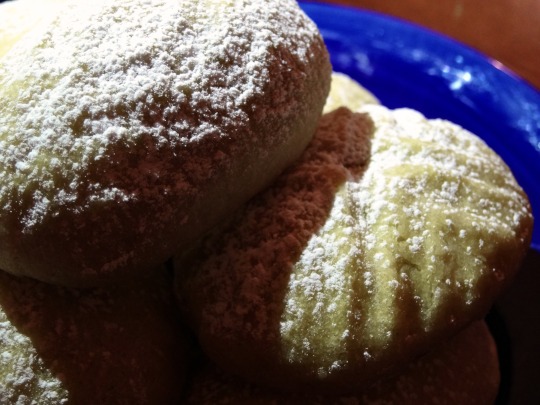
[ID: Close-up of the top of ma'moul, decorated with geometric patterns and covered in powdered sugar, in strong light and shadow. End ID]
Elsewhere
Other efforts to foreground the provenance and political-economic context of dates in a culinary setting have been made by Iraqi Jew Michael Rakowitz, whose store sold ma’moul and date syrup and informed patrons about individual people behind the hazardous transport of date imports from Iraq. Rakowitz says that his project “utilizes food as a point of entry and creates a different platform by which people can enter into conversation.”
[1] Plates from the tomb can be seen in N. de G. Davies, The tomb of Rekh-mi-Rē at Thebes, Vol. II, plates XLVII ff.
Purchase Palestinian dates
Donate to evacuate families from Gaza
Flyer campaign for eSims
Ingredients:
Makes 16 large ma'moul and 32 ka'k al-aswar; or 32 ma'moul; or 64 ka'k al-aswar.
For the dough:
360g (2 1/4 cup) fine semolina flour (سميد ناعم / طحين فرخة)
140g (1 cup + 2 Tbsp) white flour (طحين ابيض)
200g (14 Tbsp) margarine or vegetarian ghee (سمن), or olive oil
2 Tbsp (15g) powdered sugar
1 1/2 Tbsp (10g) dugga ka'k (دقة كعك)
1/2 tsp (2g) instant yeast
About 2/3 cup (190mL) water, divided (use milk if you prefer)
1 tsp toasted sesame seeds (سمسم)
1 tsp toasted nigella seeds (قزحه / حبة البركة)
Using olive oil and water for the fat and liquid in the dough is more of a rural approach to this recipe; ghee and milk (or milk powder) make for a richer cookie.
To make the bracelets easy to shape, I call for the inclusion of 1 part white flour for every 2 parts semolina (by volume). If you are only making molded cookies and like the texture of semolina flour, you can use all semolina flour; or vary the ratio as you like. Semolina flour will require more added liquid than white flour does.
For the filling:
500g pitted Madjoul dates (تمر المجهول), preferably Palestinian; or date paste
2 Tbsp oil or softened margarine
3/4 tsp dugga ka'k (دقة كعك)
3/4 tsp ground cinnamon
5 green cardamom pods, toasted, skins removed and ground; or 1/4 tsp ground cardamom
Small chunk nutmeg, toasted and ground, or 1/4 tsp ground nutmeg
10 whole cloves, toasted and ground, or 1/4 tsp ground cloves
The filling may be spiced any way you wish. Some recipes call for solely dugga ka'k (or fennel and aniseed, its main components); some for a mixture of cinnamon, cardamom, nutmeg, and/or cloves; and some for both. This recipe gives an even balance between the pungency of fennel and aniseed and the sweet spiciness of cinnamon and cloves.
Palestinian date brands include Ziyad, Zaytoun, Hasan, and Jawadir. Palestinian dates can also be purchased from Equal Exchange. You can find them online or at a local halal market. Note that an origin listed as "West Bank" does not indicate that a date company is not Israeli, as it may be based in a settlement. Avoid King Solomon, Jordan River, Mehadrin, MTex, Edom, Carmel Agrexco, Arava, and anything marked “exported by Hadiklaim”. Also avoid supermarket brands, as the origin of the dates may not be clearly marked or may be falsified to avoid boycots.
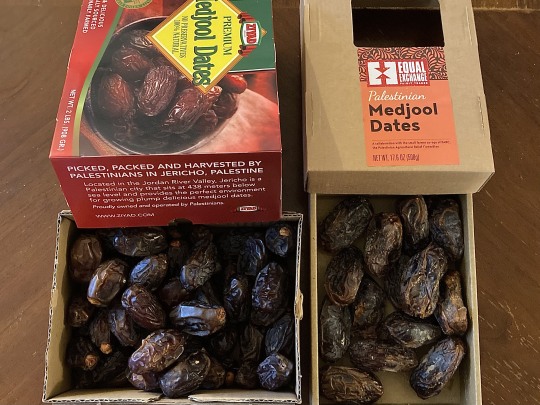
Instructions:
For the dough:
1. Melt margarine in a microwave or saucepan. Measure flours into a large mixing bowl and pour in margarine; mix thoroughly to combine. Rub flours between your hands for a few minutes to coat the grains in margarine. The texture should resemble that of coarse sad. Refrigerate the mixture overnight, or for up to 3 days.

2. Add dry ingredients to dough. If making both molded ma'moul and ka'k al-aswar, split the dough in half and add sesame and nigella seeds to one bowl.
3. Add water to each dough until you get a smooth dough that does not crack apart when formed into a ball and pressed. Press until combined and smooth, but do not over-knead—we don't want a bready texture. Set aside to rest while you make the filling.

For the filling:
1. Pit dates and check the interiors for mold. Grind all ingredients to a paste in a food processor. You may need to add a teaspoon of water, depending on the consistency of your dates.
To shape the cookies:
Divide the filling in half. One half will be used for the ma'moul, and the other half for the bracelets.
For the ma'moul:
1. With wet hands, pinch off date filling into small chunks about the size of a walnut (13-16g each, depending on the size of your mold)—or roll filling into a long log and divide into 16-20 even pieces with a dough scraper. Roll each piece of filling into a ball between your palms.
2. Divide the dough (the half without seeds) into the same number of balls as you have balls of filling, either using a kitchen scale or rolling into a log and cutting.
3. Form the dough into a cup shape. Place a ball of filling in the center, and fold the edges over to seal. Press the dough into a floured ma'moul mold to shape, then firmly tap the tip of the mold on your work surface to release; or, use a pair of spiked tweezers or a fork to add decorative designs by hand.

4. Repeat until all the the dough and filling has been used, covering the dough you're not working with to keep it from drying out. Place each cookie on a prepared baking sheet.
For the ka'k al-aswar:
1. With wet hands, divide the date filling into about 32 pieces (of about 8g each); they should each roll into a small log about the size of your pinkie finger.
2. Divide the dough (the half with the seeds) into as many pieces as you have date logs.
3. Take a ball of dough and flatten it into a thin rectangle a tiny bit longer than your date log, and about 3 times as wide. Place the date log in the center, then pull the top and bottom edges over the log and press to seal. Seal the ends.
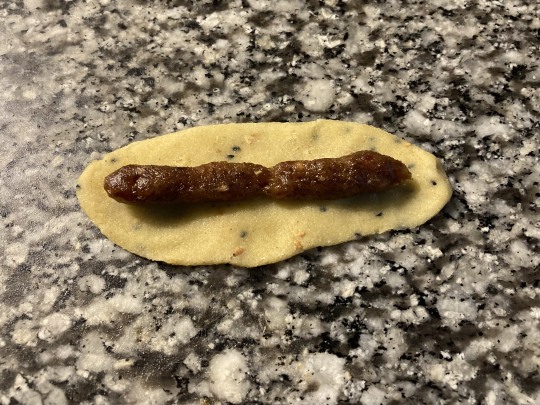
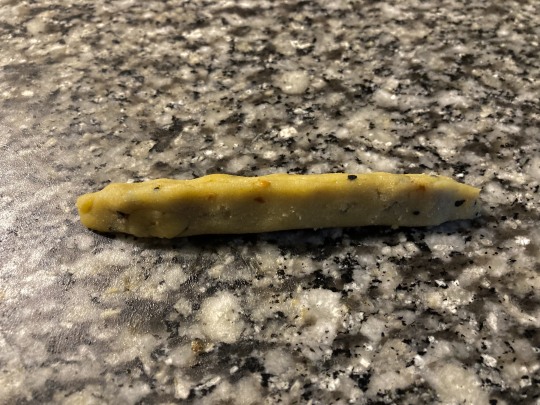
4. Roll the dough log out again to produce a thin, long rope a little bit thinner at the very ends than at the center. Press one side of the rope over the other to form a circle and press to seal.

5. Repeat until all the the dough and filling has been used, covering the dough you're not working with to keep it from drying out. Place each cookie on a prepared baking sheet.
To bake:
1. Bake ma'moul at 350 °F (175 °C) in the center of the oven for about 20 minutes, until very lightly golden brown. They will continue to firm up as they cool.
2. Increase oven heat to 400 °F (205 °C) and bake ka'k al-aswar in the top third of the oven for about 20 minutes, until golden brown.
Sprinkle cookies with powdered sugar, if desired. Store in an airtight container and serve with tea or coffee, or give to friends and neighbors.
324 notes
·
View notes
Text
October 2023 witch guide
Full moon: October 28th
New moon: October 14th
Sabbats: Samhain
October Hunter's Moon
Known as: Blood moon, drying rice moon, falling leaf moon, freezing moon, migrating moon, moon of the changing seasons, shedding moon, ten colds moon, winterfelleth & windermanoth
Element: Air
Zodiac: Libra & Scorpio
Nature spirits: Frost faeries & Plant faeries
Deities: Apollo, Astarte, Belili, Cernunnos, Demeter, Hathor, Herne, Horned God, Ishtar, Kore, Lakshmi & Mercury
Animals: Elephant, jackal, ram, scorpion & stag
Birds: Crow, heron & robin
Trees: Acacia, apple, cypress & yew
Herbs/Plants: Angelica, apple blossom, burdock, catnip, pennyroyal, sweet Annie, thyme & Uva ursi
Flowers: Calendula, cosmos & marigold
Scents: Apple blossom, cherry & strawberry
Stones: Amethyst, beryl, obsidian, opal, tourmaline & turquoise
Colors: Black, dark blue, Dark greens & purples
Energy: Artistic works, balance, creativity, harmony, inner cleansing, justice, karma, legal matters, mental stimulation, partnerships, reincarnation & uncovering mysteries or secrets
It is believed that this name originates from the fact that it was a signal for hunters to prepare for the upcoming cold winter by going hunting. This is because animals were beginning to fatten up in preparation for the winter season. Moreover, since fields had recently been cleared out under the Harvest Moon, hunters could easily spot deer and other animals that had come out to search for remaining scraps. Additionally, foxes and wolves would also come out to prey on these animals.
The earliest use of the term “Hunter’s Moon,” cited in the Oxford English Dictionary, is from 1710. Some sources suggest that other names for the Hunter’s Moon are the Sanguine or Blood Moon, either associated with the blood from hunting or the color of the changing autumn leaves.
Samhain
Also known as: All Hallow's Eve, Ancestor Night, Feast of Apples, Feast of Sam-fuim, Feast of Souls, Feast of the Dead, Geimhreadh, Hallowmass, Martinmass, Old Hallowmas, Pagan New Year, Samana, Samhuinn, Samonios, Shadowfest & Third Harvest
Season: Fall
Symbols: Apples, bats, besom(brooms), black cats, cauldrons, ghosts, gourds, jack-o-lanterns, pumpkins, scarecrows & witches
Colors: Black, gold, orange, silver & white
Oils/incense: Basil, cloves, copal, frankincense, gum mastic, heather, heliotrope, mint, myrrh & nutmeg
Animals: Bat, boar, cat cattle & dogs
Stones: Amber, anatase, black calcite, black obsidian, black tourmaline, brass, carnelian, clear quartz diamond, garnet, gold, granite, hematite, iron, jet, marble, pearl, pyrite, ruby, sandstone, sardonyx, smokey quartz, steel & tektite
Foods: Apples, ale, beef, cider, corm, fruits, garlic, gourds, grains, hazelnuts, herbal teas, mushroom, nettle, nuts, pears, pomegranates, pork, poultry, pumpkin pie, sunflower seeds, thistle, turnips & wine (mulled)
Herbs/plants: Acorn, Allspice, catnip, corn, dittany of Crete, hazel, mandrake, mugwort, mullien, oak leaves, pine, rosemary, sage, straw, tarragon, thistle, wormwood & yellow cedar
Flowers: Calendula, chrysanthemum, deadly nightshade, rue & fumitory
Goddesses: Al-lat, Baba Yaga, Badb, Banba, Bast, Bebhionn, Bronach, Brunhilde, Cailleach, Carlin, Cassandra, Cerridwen, Copper Woman, Crobh Dearg, Devanyani, Dolya, Edda, Elli, Eris, Erishkigal, Fortuna, Frau Holde, Hecate, Hel, Ishtar, Kali, Macha Mania, Morrigan, Nemesis, Nephthys, Nicneven & Rhiannon
Gods: Arawan, Baron Samede, Belenus, Coyote, Cronus, Dagda, Dis, Hades, Loki, Nefertum, Odin, Osiris, Pluto, Woden & Xocatl
Issues Intentions & Powers: Crossroads, darkness, death, divination, honoring ancestors, introspection, the otherworld/underworld, release, visions & wisdom (of the crone)
Spellwork: Divination, fire magick, night magick, shape-shifting, spirit calling & water magick
Related festivals:
• Day of the Dead- (Spanish: Día de Muertos or Día de los Muertos) is a holiday traditionally celebrated on November 1st and 2nd, though other days, such as October 31 or November 6, may be included depending on the locality. It is widely observed in Mexico, where it largely developed & is also observed in other places, especially by people of Mexican heritage. Although related to the simultaneous Christian remembrances for Hallowtide, it has a much less solemn tone and is portrayed as a holiday of joyful celebration rather than mourning. The multi-day holiday involves family and friends gathering to pay respects and to remember friends and family members who have died. These celebrations can take a humorous tone, as celebrants remember funny events and anecdotes about the departed.
• All Saints Day- is a Christian solemnity celebrated in honor of all the saints & martyrs of the Church, whether they are known or unknown
Activities:
• Dedicate an altar to loved ones who have passed
• Boil a simmer pot to cleanse your space
• Have a silent dinner
• Light a candle for your loved ones & yourself
• Decorate your house and/or altar
• Release negative energy & cleanse your with a ritual bath
• Pull tarot cards to see what may be in store for you ahead
• Cleanse, clean & de-clutter your space
• Leave offerings to the Fae
• Journal & reflect on your accomplishments, challenges & everything you did this year
•Go on a nature walk
• Learn a new form of divination
• Have a bonfire with your friends and/or family
• Carve pumpkins
• Express yourself creatively through art, music, ect
• Visit a cemetery & help clean off areas that need it or to visit a family member/ ancestor & leave an offering
• Hold a seance
• Bake spooky treats & bread as offerings
• Refresh your protection magicks, sigils & rituals
Samhain is a Gaelic festival on 1 November marking the end of the harvest season and beginning of winter or "darker half" of the year. Celebrations begin on the evening of 31 October, since the Celtic day began and ended at sunset.
This fire festival is celebrated on October 31st & is considered the Pagan New Year. It is the first Sabbat on the Wheel of the Year, a cross-quarter festival & the third (final) harvest festival of the mundane year. This is the time when the veil between the worlds of the living & those who have passed is the thinnest, which allows greater communication between the two
Some believe this is the time of the Goddess's mourning of the death of the God until his rebirth at Yule. The Goddess's sadness can be seen in the shortening, darkening days & the arrival of cold weather
Sources:
Farmersalmanac .com
Llewellyn's 2023 magical almanac: practical magic for everyday living
Wikipedia
Llewellyn's Complete Book of Correspondences by Sandra Kines
A Witch's Book of Correspondences by Viktorija Briggs
#witchcraft#wheel of the year#sabbat#samhain#fall#hunter's moon#witchblr#wiccablr#paganblr#pagan#wicca#grimoire#spellbook#book of shadows#witches of tumblr#witch tumblr#witch community#moon magic#witch tips#witch guide#beginner witch#traditional witchcraft#all witches#correspondence#witchcore#GreenWitchcrafts#baby witch#beginner witch tips#baby witch tips#witchyvibes
843 notes
·
View notes
Text
How to Use Herbs: Lavender (English Lavender)
Hello. Back with another post about how to use an herb. This time the herb is lavender. We discussed the history, powers and etc in another post (That I will link in a moment) and now we are going to see how we can use it. >>>> Post about Lavender

Alchemy Formulas:
*Remember when it says one part, try a teaspoon of it first. Always experiment with less amount than too much.
Mercury
one part lavender flowers
one part gum mastic
one part cinnamon chips
one part cinnamon oil
one part lavender oil
Air
one part gum arabic
one part cinnamon
one part lavender oil
one part clove oil
Change
one-part calamus root (Uranus; change)
one part lavender (Mercury; clarity)
one-part powdered nutmeg (Uranus; change)
one part cinnamon (Uranus, Mercury; change)
two parts sandalwood oil (Mercury, Moon; communication between conscious and subconscious minds)
Fame
one part cedar chips (Jupiter; renown)
one part angelica (Sun; authority)
one part myrtle (Venus; the arts)
one part gum mastic (Uranus; innovation)
one part lavender oil (Mercury; knowledge)
one part carnation oil (Jupiter; expansion)
Peace
one-part jasmin flowers (Moon; emotions)
one part myrrh resin (Saturn; grounding)
one part rose petals (Venus; love)
one part lotus oil (Neptune; inspiration)
one part lavender oil (Mercury; communication)
Spells:
Snake-beckoning Spell
Place an image on an altar, either of a snake or of an affiliated deity— the Minoan Serpent Goddess for instance.
Surround this with fresh lavender or warm the essential oil in an aroma burner.
Call the spirit. Be prepared to explain why you have issued the invitation.
Do this spell before bedtime, to receive a visitation in your dreams.
Don’t Sabotage My Success Spell (Workplace Edition)
Prepare a separate mojo for each person who appears to sabotage you.
Write the co-worker’s name on a square of brown paper three times.
Write your own name over each of the co-worker’s names, saying: “I cross you and I cover you.”
Anoint the corners of the paper with essential oils of bergamot, clove bud, and lavender.
Fold up the paper, placing it inside a red flannel drawstring bag, together with a devil’s shoestring root and some cumin seed.
Maintain this discreetly in the workplace, feeding daily with a drop of essential oil of lavender for reinforcement.
Herbal Beauty Glamour Spell
2 ounces of beeswax
1/2 cup coconut oil
1/2 cup olive oil
Glass measuring cup
Pan filled with water
Spoon
10 to 12 drops of lavender essential oil
10 to 12 drops of yarrow essential oil
Mirror
Pretty tin or jar
Combine the beeswax, coconut oil, and olive oil into the glass measuring cup and warm it in the pan full of water. This creates a double boiler like effect.
Once the wax melts, stir everything (the oils and beeswax) until well blended and remove it from the heat.
Add the lavender and yarrow oils, stirring them in slowly. As you do so, look into the mirror and say, I am lovely, I am desirable, I am magical. Beauty is more than skin deep. See me for the magnificence of my inner self.
Before it cools, pour your salve into a pretty tin or jar. After it has firmed up, use it on your skin.
Baths and Cleansing:
Maximum Power Spiritual Cleansing Bath
sea salt
rose and calendula blossoms
lavender oil
rose oil
rosemary oil
sandalwood oil
frankincense oil
myrrh oil
white rose hydrosol
Add copious quantities of sea salt to your bath water.
Add a drop of each essential oil into the water.
Float rose and calendula blossoms in the water, if possible.
Bath for Mercury
Herbs: lavender, white sandalwood, horehound, marjoram, thyme
Oils: lavender, white sandalwood, marjoram, anise
Self-Love Bath Bomb Bag
1 tablespoons of lavender
1 tablespoon of mandrake
1 tablespoon vervain
1 tablespoon vetivert
10-inch square of thin muslin or cotton
White ribbon
Red candle
Place the herbs in the center of the square of the cloth and gather up the corners.
Use the white ribbon to tie it, forming a pouch.
Run a warm bath and hang the pouch over the faucet, allowing the water to run through it, filling the tub with the essence of the herbs.
Light the candle and climb into the tub. Allow yourself to soak in the warm, fragrant water.
Use the herb pouch to wash your body, as you do, gaze into the candle's flame.
Visualize yourself radiating an aura of self-confidence and power. See yourself as the sort of person who attracts attention from those who are worthy.
When the water cools, extinguish the candle and get out of the tub. After you've dried yourself, dispose of the herb pouch by burying it or burning it.
Oils, Potions and Powders
Oil Blend for Patience
1 part rose
1 part lavender
1 part pine
Oil Blend for Peace
1 part violet
1 part lavender
1 part jasmine
1 part sandalwood
Masculine Oil Blend
Base note: 10 drops patchouli
Middle note: 10 drops sandalwood
Top note: 3 drops lavender
For the rest of the recipe, you will need:
1-ounce grated beeswax
Double boiler
1 ounce jojoba oil
2 metal 1-ounce containers
Flat toothpicks
Heat the grated beeswax in the double boiler until it is liquid.
Add the jojoba oil and gently mix the two ingredients together to achieve a homogenous blend.
Pour half the liquid into each container and add 3 drops of your essential oil blend.
Quickly stir the mixture with the toothpicks before the wax begins to set.
Keep one container for anointing yourself and the other as a gift to your consort so that he or she may come to appreciate you on a new level. If you are solitary and without a consort, you can use one for anointing your skin and the other for charging candles and ritual tools.
Love Potion #9
1. Choose nine love herbs. Consider these: Damiana
Ginger
Grains of Paradise
Hibiscus
Lovage
Melissa (lemon balm)
Peppermint
Red clover
Rose petals
(Other options might include adder’s tongue, cardamom pods, catnip, cubeb, lavender, red raspberry leaves or rose hips.)
2. Make a strong infusion of all the herbs, strain, and serve.
Love Powder Drawing Powder
1. Grind the following botanicals to a fine powder:
Basil
Lavender
Rose petals
Yarrow
Optional: ginger blossoms
2. Blend with rice powder.
3. Sprinkle around your home, your bedroom, on your sheets and on you.
Teas and Soothing Pillow:
Bedtime Tea
1 part lavender
1 part catnip
1 part verbena
1 part chamomile
1 cup of boiling water
Mix dry herbs into a small jar
To brew, pour 1 cup of boiling water over 1 teaspoon of the blend you made in the jar.
Steep for 5 - 7 minutes. Strain and enjoy.
Love Tea
1 part rose petals
1 part lavender
1 part jasmine
Pinch of cinnamon (optional)
1 cup of boiling water.
Mix dry herbs into a small jar
To brew, pour 1 cup of boiling water over 1 teaspoon of the blend you made in the jar.
Steep for 5 - 7 minutes. Strain and enjoy.
Dream Pillow (Hecate’s Pillow)
Hecate provides protection at night as well as psychic enhancement, so that you can journey safely during dreams. Appeal to Hecate to block nightmares too.
Dried lavender
Dried mullein
Essential oil of lavender
Optional: tuberose absolute
Blend two parts lavender to one part mullein.
Sprinkle a few drops of the essential oils over the dried botanicals.
Allow this to dry thoroughly and use it to fill a black pillow.
For optimum results, create and inaugurate the pillow during the Dark Moon or on Halloween/Samhain.
Again, sorry for such a long post. Please try to follow the instructions to the best of your abilities or mix and match and experiment. Happy witching. Bye byes~
Sources
#witch community#witchblr#green witch#witchcraft#plants and herbs#herbalist#paganblr#occulltism#nature#baby witch#teas#lavender#baths#potions#magic#witch#witchcraft 101#witches of tumblr#witchcraft resources#witch blog#beginner witch
222 notes
·
View notes
Text
Hmm:

Regarding tenzu tablets:
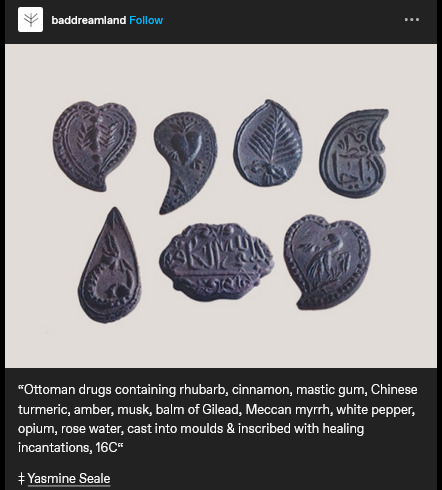
Caption reads: "Ottoman drugs containing rhubarb, cinnamon, mastic gum, Chinese tumeric, amber, musk, balm of Gilead, Meccan myrrh, white pepper, opium, rose water, cast into moulds & inscribed with healing incantations, 16C". Credited with a link to Yasmine Seale, on social media.
Original linked source doesn't mention where these particular tablets/molds were created, kept, displayed, etc. But I wanted to learn more and found a kinda recent summary of tenzu which was published by Nil Sarı (head of History of Medicine and Ethics Department at Istanbul University's Cerrahpasha medical school, president of Health History and Museology Association), which was presented at a conference in 2016:
Nil Sarı. "The Special Pharmaceutical Tablet “Tenzu” in Ottoman Medicine.” 7th International Congress for History of Islamic Medicine, October 24-28, Fez, Morocco, 2016: 24-28.
An excerpt of the text:
In Ottoman Turkish tenzu (tensuh) means "very rare beautiful thing" or "a box containing a variety of fragrances." Tenzu was also said to be the name of a place in Hitay (Eastern Turkistan / Xinjiang) where a medicinal clay - the main ingredient of the tablet tenzu - was imported from. Tenzu was a kind of theriac said to be effective against various ailments. Different tenzu prescriptions are noted in the texts [...] of several medical manuscripts of the 17th and 18th centuries. These tenzu prescriptions were described by various physicians, e.g. the head physicians Salih bin Nasrullah and Nuh Efendi as well as Hayatizade Mustafa Feyzi and Shaban Shifai who were palace physicians of the period. The special pharmaceutical tablet/pastille named "tenzu kursu" was formed in various shapes, i.e. oval, round, or rectangular. A measured amount of the drug preparation was compressed and shaped in a special brass mold named "tenzu kalibi" in Turkish. [...]
Prayers and ornamentations are engraved on the metal molds [...]. The expressions Deva al kulub (Drug for the heart) and Shifa al marghoob (The desired, yearned healing) inscribed on molds reinforce spirituality. [...] Inscriptions around the center of the other flower shaped pattern are Ferd, Hayy, Kayyum and feehi shifaun lin-naas (wherein is healing for mankind, Surah an-Nahl, verse 69). [...] Al-Hayy and Al-Qayyum are often used together. Al-Hayy signifies "ever-lasting life", and Al-Qayyum "self-existing life". [...] Sihhat bad (Have a good health) and Afiyet bad (Have a good appetite) are inscribed. [...] A. Suheyl Unver and Hayri Sozen published several tenzu prescriptions in their book "Turk Farmakaloji Tarihi I.", in 1960. [...] Tenzu prescriptions are found in several medical manuscripts kept in the Topkapi Palace Library, Suleymaniye Library and Istanbul University Rare Books Library.
Clay is a main ingredient [...]. Tiyn-i Tenzu is an unknown red colored clay. However, Terra Sigillata (Tiyn-i mahtum / muhurlu toprak) and Armenian Clay (Kil ermeni) are found in the prescriptions. [...] There are also animal products in the compositions, i.e. ambergris (amber), bezoar (badzehr), kermes (kirmiz), musk (misk), raw silk (harir-i ham / ham ipek), [...] and burnt deer antler (yanmisgeyik boynuzu). There are a wide variety of herbal drugs in the compositions, i.e. Acorus calamus [...], Aloe vera (Sabir), [...] Anchusa offinalis (Lisan-i sevr cicegi), Artemisia absinthium [...], Bambusa arundinaceae [...], Chenopodium album [...], Cinnamon (Darcin), Citrus aurantium [...], Crocus sativus (Za'feran), Embellia ribes [...], Gummi mastix [...], Heliotropium arborsecens [...], Nardustachys jatamansi [...], Potentilla reptans [...], Pterocarpus santalinus [...], Red rose/Rosa gallica [...], Rheum officinale (Ravend), Rumez acetosellaseed [...], Ruta graveolens (Keci Sadefi/Sedef Otu), Terminalia citrina [...], Terminalia chebula [...], Tormentilla (Tormentila).
Shaping and storage of these drugs are explained alongside some of the tenzu prescriptions. According to a recipe, all ingredients are beaten very thin on a porphyry (onyx marble) [...]. Each dose wrapped in gold foil is anointed an amount of almond oil. It is pressed into the mold, dried in the shade and stored in wood boxes. [...] Drugs in tablet form was an old tradition. In general, the preparation is poured onto a tray. [...] After dried in the shade, orange leaves are put between them. Stored in colored glass containers, they're reused when needed, squashed with water and drunk as a syrup. Also, flat pills made of a drachma weight were retained on the tongue in the mouth [...]. Although drugs in tablet form were used throughout Ottoman history either as a pastille or to be converted into syrup, the tenzu tablet molds were designed for the Ottoman sultans and members of the dynasty to make special tablets decorated with calligraphy [...].
[End of excerpt.]
All of these images are cropped screenshots of the PDF scan of the printed "conference works"; the PDF was uploaded online by Nil Sarı.


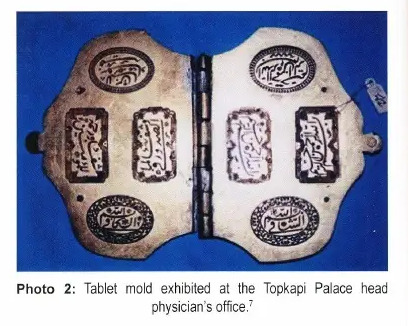

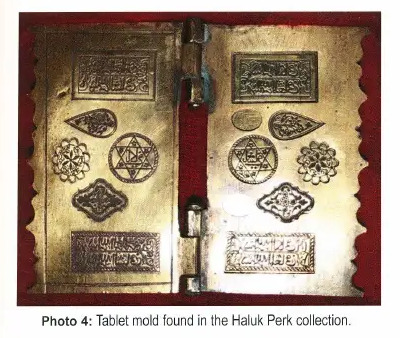
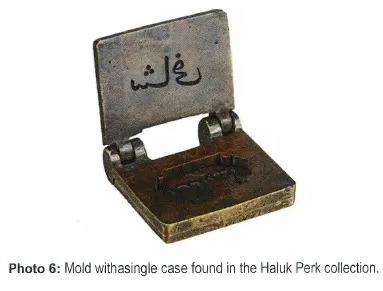
#sorry some of the non english is messed up because i had to transcribe the text myself from the image scans#also like that the Special Sweets Kitchen of the palace produced medicine
132 notes
·
View notes
Text

Mastic Gum - Klaire Labs
Mastic Gum is a sap like substance that comes from the mastic tree. It is chewed, like chewing gum, to alleviate digestive related conditions such as indigestion, heartburn and stomach pain. Mastic gum contains anti-bacterial, anti-fungal, anti-oxidant, and anti-inflammatory properties which enable it to provide relief from uncomfortable symptoms. Chewing mastic gum daily may help protect the stomach and gut from gastrointestinal problems.
Tablets are cinnamon flavoured and contain DGL (deglycyrrhizinated licorice root and rhizome extract). DGL is a soothing anti inflammatory herb, used for heartburn and stomach inflammation. It relieves symptoms and repairs the lining of the digestive tract.
Know more: Mastic Gum
#Mastic Gum#klaire labs supplements#best dietary supplements uk#pure natural supplements#pure nature supplements#Shop best natural supplements#health supplements online in uk#best quality supplements uk
1 note
·
View note
Text
Ode to Dining Hall Meals With Friends
Come friend,
Let us sit upon this discolored chair
At this soda-sticky table
We both have teeth
Enamel coated and off-white
Perfect for chewing
Our enzymes work in tandem
Masticating carbs
Into sugar
Tell me about your day
Do you like your food?
Is this what you dreamed of?
How do you think you’re going to die?
Laugh with me
In between sips of something that’s either
Mountain Dew or battery acid
Smear the grease on your lips with a napkin
Brush the crumbs off your lap
Let our presence linger like
The taste of garlic on the tongue
Wash it out with chewing gum
Come friend,
Share this meal
We are hungry
And we are sated
And we are loved.
by Feygeh S
54 notes
·
View notes
Text
The Witcher Headcanon (Modern Au) - Error 404 Brain Not Found: Bonus Scene - Part 8
"I dare you to lick that!"
"I dare you to eat that!"
Those two phrases had been spoken off and on as Geralt and Jaskier travelled on the Path, looking for contracts.
Geralt had pulled into a gas station to refuel and take a p*ss break.
"I dare you to lick the toilet seat." Geralt said as he washed his hands.
Jaskier's head snapped towards him, incredulous. "Lick a gas staton toilet seat? I wouldn't even lick the toilet seat at home!"
"Ok, then I dare you to lick the urinal instead,"
Jaskier paled. "No! No, I'll lick the seat..." He went into the stall, Geralt following to confirm he actually did it. Jaskier faced the toilet seat.
It sat before him, stained, dingy, yellowed and cracked with age, and probably teeming with germs and diseases. And it probably hadn't been cleaned properly...ever.
"If I catch some godsd*mned horrible disease and die, it'll be on your head!"
"Hmm!"
*offended gasp* "What do you mean I've put my mouth on dirtier things?"
"Hm!"
"Yeah? Well, at least I knew where those things had been...er... At least I knew they were...knew I was the only one....er...."
"Fine. I see your point."
Jaskier crouched close to the commode and hesitated, staring at the filthy seat. The filthy seat with p*ss stains so thick, they looked like butter, and sh*t residue that would require a grinder and bleach to remove.
And oh, gods, was that gummy stuff what he thought it was???
He thought about backing out right then, but shoved the thought away. Julian Alfred Pankratz did not pull out back out!
Jaskier said a brief prayer, then closed his eyes and licked the toilet seat.
Geralt snapped a picutre with his phone. For documentation purpose. Yeah. It absolutely wasn't so he could send it to his brothers.
Jaskier immediately spat and splashed water from the sink faucet on his tongue, then rushed to Roach to disinfect his mouth with a little whiskey while Geralt went to fill up the gas tank.
The gas station attendand looked out the window a few minutes after the Witcher had paid and gone back outside, and saw him on his hands and knees next to his van.
Was he ill? Did he drop something?
No. As the attendant watched, confused as h*ll, the Witcher leaned down and licked an oil stain while his companion laughed. Then he got up, they both got in the van, and they drove away. Well, that was going to be a fun story to tell.
Geralt stopped in the next town for lunch. He sat at the table, looking over the restaraunt menu while he waited for his drink. He gripped the underside of the table with one hand to help pull himself closer, and put his hand in someone's chewing gum.
"I dare you to chew that!" Jaskier said, as Geralt went to pick the gum off his fingers with a paper napkin. Geralt made a face. He didn't really want to chew someone else's gum, but he didn't want the undesired consequence of getting kicked in the nads for turning down a dare. He was a Witcher, so he was immune to most diseases anyway, which worked out in his favor. A little A.B.C. gum wasn't going to kill him.
So Geralt chewed the pre-masticated gum.
"What does it taste like?" Jaskier whispered out of morbid curiosity.
"Hmm. Spearmint. Cigarettes..." Geralt rumbled as he chewed, "Cheese, or something sweet. I can't really place it. Oh, wait. Bad kidneys. Probably from diabeetes."
"That sucks for him." Jaskier said, not even questioning Geralt's analysis. It was a Witcher Thing.
"Her."
"You can stop now."
*smug hmmm.*
Later that day, Jaskier almost ate an earthworm Geralt found under a rock as they wandered through the woods, looking for nekkers.
Almost, because he ended up spitting it out after trying to be funny and suck it up like a spaghetti noodle. Geralt had doubled over laughing as Jaskier gagged on the worm. Jaskier's face had twisted up, and he'd made this humorus gargling noise before spitting the worm out.
Jaskier dared Geralt to lick a sticky substance off the side of a tree. It was probably sap. It was difficult tell. It wasn't particularly sap-colored, and didn't have that resin smell.
Geralt couldn't sense anything toxic about it, so he leaned in and licked the stream of goo. Hm. That was an odd flavor. It tasted kind of like...goat and something musky...
Geralt gagged and grabbed his canteene. He desperately started rinsing his mouth.
"What?" Jaskier asked, hovering between concern and confusion. Geralt babbled something about dryads and satyrs f***ing as he spat and gargled frantically. "That's not sap!" he screamed in lowercase.
Jaskier gasped, then ugly laughed, "You-you licked satyr nut!"
"Do you mind?" the tree grumbled in Elder, in a crabby tone, "I'm kind of worn out and would like to sleep!"
"You licked satyr nut off a treeussy!" Jaskier said to Geralt out of the corner of his mouth before addressing the dryad. Geralt elbowed him sharply in the ribs.
"A thousand appologies! We didn't mean to disturb you," Jaskier paused to bow slightly before continuing, "My friend and I were just passing through, and we will be on our way now."
The tree grumbled and shook its branches in a shooing motion at them.
They quickly left.
Geralt spat periodically as they walked in silence, a vaguely haunted look on his face.
"Dare Truce?" Jaskier offered.
"Dare Truce."
#the witcher#the witcher netflix#twn#the witcher headcanon#the witcher modern au#geralt#geralt of rivia#jaskier#julian alfred pankratz#geraskier#error 404 brain not found headcanon#error 404 headcanon#brain not found headcanon
21 notes
·
View notes
Text
Nevularxi: HUMAN, be careful! my scanners indicate the material which you are about to eat is not digestible by humans!
Lt. Commander Killian: you mean my gum? I’m not gonna swallow it.
Nevularxi: Then wh-
Lt. Commander Killian: It’s gum. you guys don’t have gum?
Nevularxi: … No, our planet does not have ‘gum.’
Lt. Commander Killian: Okay, well, you chew on it.
Nevularxi: You chew on it… I see, so this is some sort of ruminant digestion then, where the continued pulverization of the material in the presence of the enzymes in your saliva render the material into digestible compounds over time!
Lt. Commander Killian: what? no. you just chew on it.
Nevularxi: You just…
Lt. Commander Killian: yup.
Nevularxi: You just masticate on it perpetually until… for what? does it improve the strength of your teeth?
Lt. Commander Killian: No? i mean, some of them do. this one doesn’t. but it tastes good. and it makes my breath all minty fresh, see?
Nevularxi: And what do you do with the spent material when you need to use your mouth for other purposes?
Lt. Commander Killian: well if you’re a good person you throw it away, but most people just stick it on the underside of something and forget about it.
Nevularxi: Don’t… don’t tell me that this is what the unidentified lump of semi-organic matter i found stuck to my desk was…
Lt. Commander Killian: haha, fun to know it happens to aliens too.
263 notes
·
View notes
Text
@calliemity wanted to see my teeth poem so here is my teeth poem
- (Short version)
Set on the Teeth
Life is meant to be more set on the teeth
More gnawed
Gnashed and jawed
More tested for sweet
Nipped like an unfamiliar hand on the snout
More to follow the molar curve
And pressed sharpness to the tongue
Oh man the mastication
Oh man the hinge and the gum
The alligator on my chin
The rain makes its leap
from jaw to collarbone
and the spit finds the corner of the lip
The skin breaks and makes
some sudden red
Life’s meant more set to the teeth
More traced palette
More bitten cheek
I will set my life to the teeth
I pledge to all the rotten meat
I will set my rotten soul on the teeth
From the honeysuckle to raw concrete
Life is so bitingly sweet
-
(Long / more rhyme-heavy version below the cut)
Set to the Teeth
Life is meant to be
more set to the teeth
More gnawed
More jawed
More tested for sweet
Nipped like the hand
on the nose of the beast
If the hot skin doesn't smell familiar
More to follow the molar curve
And pressed knife to the tongue
Like the bite-born killer
the tooth and the turn
the wolf in the wound
its the lunge
its the plunge
its the blood on the bullet
Set to bone and set to stone
and set unto the terrible teeth
Oh man the mastication
Oh man the hinge and gum
The alligator on my chin
The cut lets out
The lip lets in
Oh man oh man the allig-ation
The drool takes the drop
from jaw to collarbone
The spit finds the corner of the mouth
The skin breaks and makes
some sudden red
Oh gotta get it out
Life’s meant more set to the teeth
More traced palette
And more bitten cheek
I will set my life to the teeth
I pledge to all the rotten meat
I will set my rotten soul on the teeth
From the honeysuckle to raw concrete
Life is so bitingly sweet
Set to the terrible teeth
Set to the terrible teeth
-
If anyone wants to share their poems you can take this as an opportunity to do so! You could rb this with a poem or make your own post. I know @ricky-mortis and @calliemity write poetry so I nominate them, no pressure ofc! If you can’t decide on a poem u can use the prompt “teeth” or use one that fits it most closely :]
12 notes
·
View notes